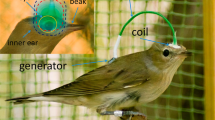Abstract
MIGRATORY birds use a variety of environmental stimuli in orientation. Species that migrate primarily at night can use compasses based on the geomagnetic field, stars, the Sun and patterns of skylight polarization1–4. These compass mechanisms can interact both when migratory birds make day-to-day orientation decisions5 and during their ontogeny in young birds6,7. All of the known compasses used by migratory birds seem to be modifiable by experience during early development. For example, a functional magnetic compass develops in birds that have never seen the sky8–11. But the preferred direction of orientation by the magnetic compass may be modified during the first three months of life by exposing naive birds to the sky under conditions in which magnetic directions differ substantially from compass directions indicated by the Sun and stars (true or geographic directions)6,9,10. For hand-raised Savannah sparrows (Passerculus sandwichensis), experience with either the clear daytime or night sky is sufficient to effect this calibration of the magnetic compass11. We therefore proposed that celestial rotation, which provides a source of geographic directions both day and night, is the calibrating reference. Here we report that the rotation of an artificial pattern of 'stars' calibrates the preferred direction of magnetic orientation of young Savannah sparrows.
This is a preview of subscription content, access via your institution
Access options
Subscribe to this journal
Receive 51 print issues and online access
$199.00 per year
only $3.90 per issue
Buy this article
- Purchase on Springer Link
- Instant access to full article PDF
Prices may be subject to local taxes which are calculated during checkout
Similar content being viewed by others
References
Wiltschko, W. Comp. Biochem. Physiol. 76A 709–717 (1983).
Baker, R. R. Bird Navigation: The Solution of a Mystery? (Holmes & Meier, London, 1984).
Able, K. P. & Cherry, J. D. in Migration: Mechanisms and Adaptive Significance (ed. Rankin, M. A.) 516–525 (Marine Sci. Inst. Univ. Texas, Port Aransas, 1985).
Moore, F. R. Biol. Rev. 62, 65–86 (1987).
Wiltschko, W. & Wiltschko, R. Trends Ecol. Evol. 3, 13–15 (1988).
Able, K. P. & Bingman, V. P. Q. Rev. Biol. 62, 1–29 (1987).
Able, K. P. Experientia 46, 388–394 (1990).
Wiltschko, W. & Gwinner, E. Naturwissenschaften 61, 406 (1974).
Bingman, V. P. Behaviour 87, 43–53 (1983).
Bingman, V. P., Beck, W. & Wiltschko, W. in Migration: Mechanisms and Adaptive Significance (ed. Rankin, M. A.) 544–552 (Marine Sci. Inst., Univ. Texas, Port Aransas, 1985).
Able, K. P. & Able, M. A. Anim. Behav. 39, 905 (1990).
Bingman, V. P. Anim. Behav. 29, 962–963 (1981).
Moore, F. R. Anim. Behav. 28, 684–704 (1980).
Moore, F. R. Anim. Behav. 33, 657–663 (1985).
Able, K. P. & Able, M. A. Anim. Behav. 39, 1189 (1990).
Wiltschko, W. & Wiltschko, R. J. comp. Physiol. A109, 91–99 (1976).
Emlen, S. T. & Emlen, J. T. Auk 83, 361–367 (1966).
Emlen, S. T. Science 170, 1198–1201 (1970).
Wiltschko, W., Daum, P., Fergenbauer-Kimmel, A. & Wiltschko, R. Ethology 74, 285–292 (1987).
Batschelet, E. Circular Statistics in Biology (Academic, New York, 1981).
Cherry, J. D. & Able, K. P. Auk 103, 225–227 (1986).
Author information
Authors and Affiliations
Rights and permissions
About this article
Cite this article
Able, K., Able, M. Calibration of the magnetic compass of a migratory bird by celestial rotation. Nature 347, 378–380 (1990). https://doi.org/10.1038/347378a0
Received:
Published:
Issue Date:
DOI: https://doi.org/10.1038/347378a0
This article is cited by
-
Feasibility of sun and magnetic compass mechanisms in avian long-distance migration
Movement Ecology (2018)
-
Navigation
Journal of Comparative Physiology A (2017)
-
Cue-conflict experiments between magnetic and visual cues in dunlin Calidris alpina and curlew sandpiper Calidris ferruginea
Behavioral Ecology and Sociobiology (2017)
-
Re-calibration of the magnetic compass in hand-raised European robins (Erithacus rubecula)
Scientific Reports (2015)
-
Star compass learning: how long does it take?
Journal of Ornithology (2014)
Comments
By submitting a comment you agree to abide by our Terms and Community Guidelines. If you find something abusive or that does not comply with our terms or guidelines please flag it as inappropriate.



